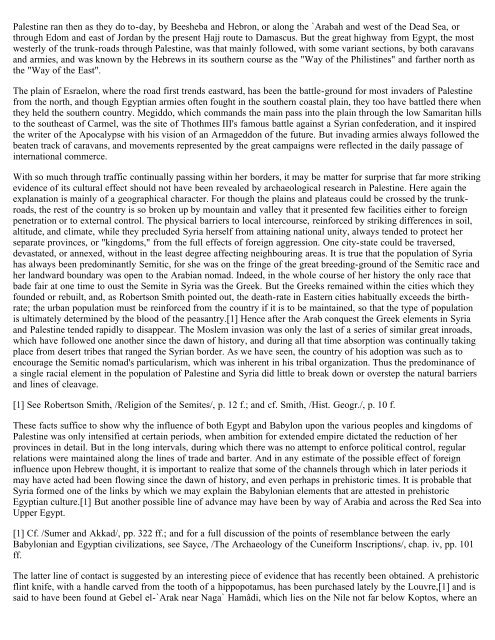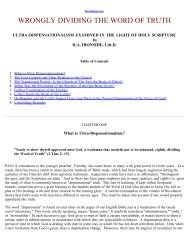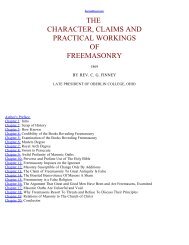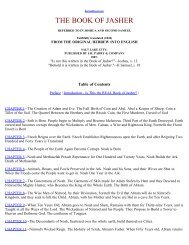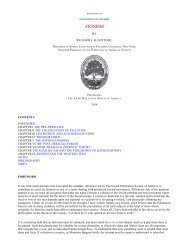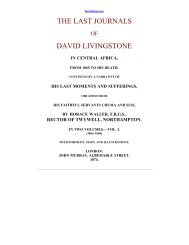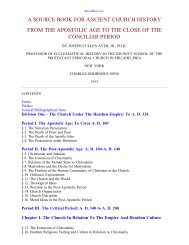Legends of Babylon and Egypt in Relation to Hebrew Tradition.pdf
Legends of Babylon and Egypt in Relation to Hebrew Tradition.pdf
Legends of Babylon and Egypt in Relation to Hebrew Tradition.pdf
Create successful ePaper yourself
Turn your PDF publications into a flip-book with our unique Google optimized e-Paper software.
Palest<strong>in</strong>e ran then as they do <strong>to</strong>-day, by Beesheba <strong>and</strong> Hebron, or along the `Arabah <strong>and</strong> west <strong>of</strong> the Dead Sea, or<br />
through Edom <strong>and</strong> east <strong>of</strong> Jordan by the present Hajj route <strong>to</strong> Damascus. But the great highway from <strong>Egypt</strong>, the most<br />
westerly <strong>of</strong> the trunk-roads through Palest<strong>in</strong>e, was that ma<strong>in</strong>ly followed, with some variant sections, by both caravans<br />
<strong>and</strong> armies, <strong>and</strong> was known by the <strong>Hebrew</strong>s <strong>in</strong> its southern course as the "Way <strong>of</strong> the Philist<strong>in</strong>es" <strong>and</strong> farther north as<br />
the "Way <strong>of</strong> the East".<br />
The pla<strong>in</strong> <strong>of</strong> Esraelon, where the road first trends eastward, has been the battle-ground for most <strong>in</strong>vaders <strong>of</strong> Palest<strong>in</strong>e<br />
from the north, <strong>and</strong> though <strong>Egypt</strong>ian armies <strong>of</strong>ten fought <strong>in</strong> the southern coastal pla<strong>in</strong>, they <strong>to</strong>o have battled there when<br />
they held the southern country. Megiddo, which comm<strong>and</strong>s the ma<strong>in</strong> pass <strong>in</strong><strong>to</strong> the pla<strong>in</strong> through the low Samaritan hills<br />
<strong>to</strong> the southeast <strong>of</strong> Carmel, was the site <strong>of</strong> Thothmes III's famous battle aga<strong>in</strong>st a Syrian confederation, <strong>and</strong> it <strong>in</strong>spired<br />
the writer <strong>of</strong> the Apocalypse with his vision <strong>of</strong> an Armageddon <strong>of</strong> the future. But <strong>in</strong>vad<strong>in</strong>g armies always followed the<br />
beaten track <strong>of</strong> caravans, <strong>and</strong> movements represented by the great campaigns were reflected <strong>in</strong> the daily passage <strong>of</strong><br />
<strong>in</strong>ternational commerce.<br />
With so much through traffic cont<strong>in</strong>ually pass<strong>in</strong>g with<strong>in</strong> her borders, it may be matter for surprise that far more strik<strong>in</strong>g<br />
evidence <strong>of</strong> its cultural effect should not have been revealed by archaeological research <strong>in</strong> Palest<strong>in</strong>e. Here aga<strong>in</strong> the<br />
explanation is ma<strong>in</strong>ly <strong>of</strong> a geographical character. For though the pla<strong>in</strong>s <strong>and</strong> plateaus could be crossed by the trunkroads,<br />
the rest <strong>of</strong> the country is so broken up by mounta<strong>in</strong> <strong>and</strong> valley that it presented few facilities either <strong>to</strong> foreign<br />
penetration or <strong>to</strong> external control. The physical barriers <strong>to</strong> local <strong>in</strong>tercourse, re<strong>in</strong>forced by strik<strong>in</strong>g differences <strong>in</strong> soil,<br />
altitude, <strong>and</strong> climate, while they precluded Syria herself from atta<strong>in</strong><strong>in</strong>g national unity, always tended <strong>to</strong> protect her<br />
separate prov<strong>in</strong>ces, or "k<strong>in</strong>gdoms," from the full effects <strong>of</strong> foreign aggression. One city-state could be traversed,<br />
devastated, or annexed, without <strong>in</strong> the least degree affect<strong>in</strong>g neighbour<strong>in</strong>g areas. It is true that the population <strong>of</strong> Syria<br />
has always been predom<strong>in</strong>antly Semitic, for she was on the fr<strong>in</strong>ge <strong>of</strong> the great breed<strong>in</strong>g-ground <strong>of</strong> the Semitic race <strong>and</strong><br />
her l<strong>and</strong>ward boundary was open <strong>to</strong> the Arabian nomad. Indeed, <strong>in</strong> the whole course <strong>of</strong> her his<strong>to</strong>ry the only race that<br />
bade fair at one time <strong>to</strong> oust the Semite <strong>in</strong> Syria was the Greek. But the Greeks rema<strong>in</strong>ed with<strong>in</strong> the cities which they<br />
founded or rebuilt, <strong>and</strong>, as Robertson Smith po<strong>in</strong>ted out, the death-rate <strong>in</strong> Eastern cities habitually exceeds the birthrate;<br />
the urban population must be re<strong>in</strong>forced from the country if it is <strong>to</strong> be ma<strong>in</strong>ta<strong>in</strong>ed, so that the type <strong>of</strong> population<br />
is ultimately determ<strong>in</strong>ed by the blood <strong>of</strong> the peasantry.[1] Hence after the Arab conquest the Greek elements <strong>in</strong> Syria<br />
<strong>and</strong> Palest<strong>in</strong>e tended rapidly <strong>to</strong> disappear. The Moslem <strong>in</strong>vasion was only the last <strong>of</strong> a series <strong>of</strong> similar great <strong>in</strong>roads,<br />
which have followed one another s<strong>in</strong>ce the dawn <strong>of</strong> his<strong>to</strong>ry, <strong>and</strong> dur<strong>in</strong>g all that time absorption was cont<strong>in</strong>ually tak<strong>in</strong>g<br />
place from desert tribes that ranged the Syrian border. As we have seen, the country <strong>of</strong> his adoption was such as <strong>to</strong><br />
encourage the Semitic nomad's particularism, which was <strong>in</strong>herent <strong>in</strong> his tribal organization. Thus the predom<strong>in</strong>ance <strong>of</strong><br />
a s<strong>in</strong>gle racial element <strong>in</strong> the population <strong>of</strong> Palest<strong>in</strong>e <strong>and</strong> Syria did little <strong>to</strong> break down or overstep the natural barriers<br />
<strong>and</strong> l<strong>in</strong>es <strong>of</strong> cleavage.<br />
[1] See Robertson Smith, /Religion <strong>of</strong> the Semites/, p. 12 f.; <strong>and</strong> cf. Smith, /Hist. Geogr./, p. 10 f.<br />
These facts suffice <strong>to</strong> show why the <strong>in</strong>fluence <strong>of</strong> both <strong>Egypt</strong> <strong>and</strong> <strong>Babylon</strong> upon the various peoples <strong>and</strong> k<strong>in</strong>gdoms <strong>of</strong><br />
Palest<strong>in</strong>e was only <strong>in</strong>tensified at certa<strong>in</strong> periods, when ambition for extended empire dictated the reduction <strong>of</strong> her<br />
prov<strong>in</strong>ces <strong>in</strong> detail. But <strong>in</strong> the long <strong>in</strong>tervals, dur<strong>in</strong>g which there was no attempt <strong>to</strong> enforce political control, regular<br />
relations were ma<strong>in</strong>ta<strong>in</strong>ed along the l<strong>in</strong>es <strong>of</strong> trade <strong>and</strong> barter. And <strong>in</strong> any estimate <strong>of</strong> the possible effect <strong>of</strong> foreign<br />
<strong>in</strong>fluence upon <strong>Hebrew</strong> thought, it is important <strong>to</strong> realize that some <strong>of</strong> the channels through which <strong>in</strong> later periods it<br />
may have acted had been flow<strong>in</strong>g s<strong>in</strong>ce the dawn <strong>of</strong> his<strong>to</strong>ry, <strong>and</strong> even perhaps <strong>in</strong> prehis<strong>to</strong>ric times. It is probable that<br />
Syria formed one <strong>of</strong> the l<strong>in</strong>ks by which we may expla<strong>in</strong> the <strong>Babylon</strong>ian elements that are attested <strong>in</strong> prehis<strong>to</strong>ric<br />
<strong>Egypt</strong>ian culture.[1] But another possible l<strong>in</strong>e <strong>of</strong> advance may have been by way <strong>of</strong> Arabia <strong>and</strong> across the Red Sea <strong>in</strong><strong>to</strong><br />
Upper <strong>Egypt</strong>.<br />
[1] Cf. /Sumer <strong>and</strong> Akkad/, pp. 322 ff.; <strong>and</strong> for a full discussion <strong>of</strong> the po<strong>in</strong>ts <strong>of</strong> resemblance between the early<br />
<strong>Babylon</strong>ian <strong>and</strong> <strong>Egypt</strong>ian civilizations, see Sayce, /The Archaeology <strong>of</strong> the Cuneiform Inscriptions/, chap. iv, pp. 101<br />
ff.<br />
The latter l<strong>in</strong>e <strong>of</strong> contact is suggested by an <strong>in</strong>terest<strong>in</strong>g piece <strong>of</strong> evidence that has recently been obta<strong>in</strong>ed. A prehis<strong>to</strong>ric<br />
fl<strong>in</strong>t knife, with a h<strong>and</strong>le carved from the <strong>to</strong>oth <strong>of</strong> a hippopotamus, has been purchased lately by the Louvre,[1] <strong>and</strong> is<br />
said <strong>to</strong> have been found at Gebel el-`Arak near Naga` Hamâdi, which lies on the Nile not far below Kop<strong>to</strong>s, where an


